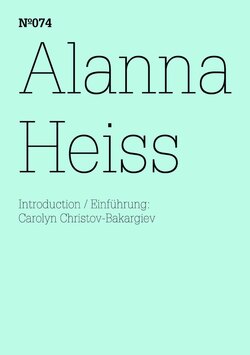Читать книгу Alanna Heiss - Alanna Heiss - Страница 2
ОглавлениеIntroduction
Carolyn
Christov-Bakargiev
The text that follows was a lecture given by Alanna Heiss during a conference that took place April 26–29, 1978, at LAICA, the Los Angeles Institute of Contemporary Art, housed on 2020 South Robertson Boulevard. Heiss’ text was published in a book titled The New Arts Space: A Summary of Alternative Visual Arts Organizations Prepared in Conjunction with a Conference. It focused on “curatorial” practice (this may be one of the first texts to use that adjectivized noun so common today), at a time when curating was not constituted as a parallel and at times even competitive practice to artistic research.
In 1971, Alanna Heiss (b. 1943, Louisville, Kentucky), who worked in the arts in New York, filed for a four-day permit to conduct a film shoot under the Brooklyn Bridge. Instead, she organized an exhibition of contemporary art and performances there, which took place on May 24. She included more than twenty artists, such as Carl Andre, Bill Bollinger, Jene Highstein (her partner at the time), Sol LeWitt, Richard Nonas, Dennis Oppenheim, Philip Glass, Gordon Matta-Clark, and Dorothea Rockburne. Shortly afterward, she founded the non-profit Institute for Art and Urban Resources, dedicated to utilizing abandoned buildings all over New York for exhibitions, performances, and studios. She was close to artists such as Matta-Clark and others whose urban interventions inspired her practice outside the modernist white cube. Among the important venues of the institute was the Clocktower in downtown Manhattan, which provided a location for various radical events and artworks such as Matta-Clark’s Clock Shower. In 1976, the exhibition “Rooms” at an old school building in Queens led to the new P.S.1 Contemporary Art Center/Institute for Art and Urban Resources. During the next thirty-five years, in collaboration with many curators drawn to P.S.1, Heiss organized more than 2,000 exhibitions in all media. Many years later, in 2000, P.S.1 merged with the Museum of Modern Art, and eight years later, in 2008, Heiss left P.S.1 to return to the Clocktower Gallery and run its exhibition, residency, performance, and online radio programs, operating at www.ARTonAIR.org.
P.S.1 was so named because it was located in what had once been a public school, across from a taxi parking lot and the post office on Forty-Sixth Avenue, and near the subway stop on the 7 line, which cuts horizontally across from the outskirts of Flushing in Queens all the way to Times Square on Forty-Second Street. A particularly diverse and eclectic set of subway riders are found on the 7 line.
Heiss’ way of working has always been based on a belief in and commitment toward artists. In the early 1970s, when applying for funds and needing to fill in a line on the application form where it was requested that the applicant state what type of institution they were applying for, Heiss decided to write “alternative space” as an expression that would appear institutional enough to gain support while vague enough to stay outside the system. Since then, this term has become standard to indicate artist-run spaces and other independent or non-profit art spaces. The possibility of the alternative, of an alter-worldliness, the potential within the space for otherness, even to oneself, all remain political, aesthetic, social, psychological, and scientific questions of great importance. The alternative is the space not of normalization, but of the hōs mē—a space to act as if the actual condition were not, to act therefore with the imagination, as if we were already after, already elsewhere, without waiting for solutions proposed by existing political systems.
Carolyn Christov-Bakargiev (b. 1957) is Artistic Director of dOCUMENTA (13).
